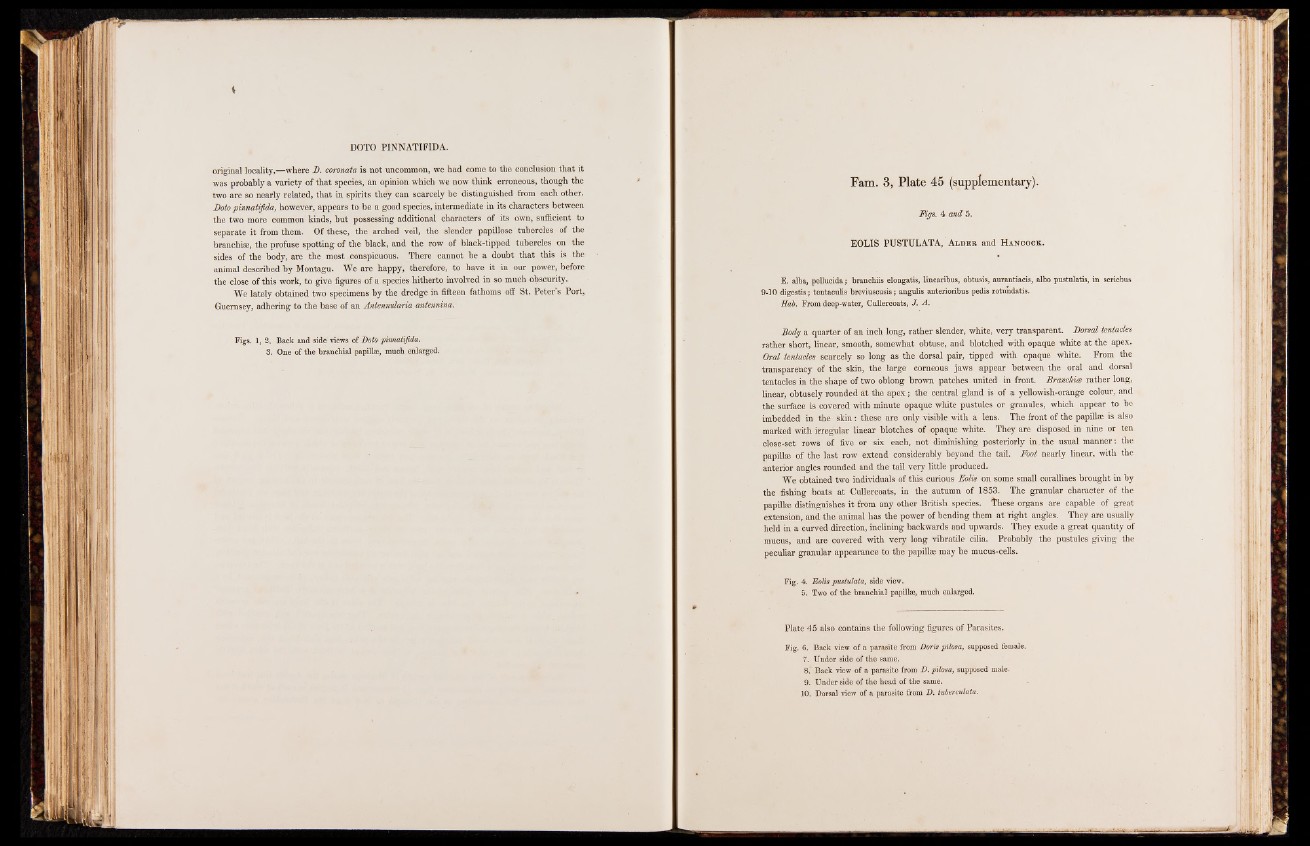
original locality,—where D. coronata is not uncommon, we had come to the conclusion that it
was probably a variety of that species, an opinion which we now think erroneous, though the
two are so nearly related, that in spirits they can scarcely be distinguished from each other.
Doto pinnatifida, however, appears to be a good species, intermediate in its characters between
the two more common kinds, but possessing additional characters of its own, sufficient to
separate it from them. Of these, the arched veil, the slender papillose tubercles of the
branchiae, the profuse spotting of the black, and the row of black-tipped tubercles on the
sides of the body, are the most. conspicuous. There cannot be a doubt that this is the
animal described by Montagu. We are happy, therefore, to have it in our power, before
the close of this work, to give figures of a species hitherto involved in so much obscurity.
We lately obtained two specimens by the dredge in fifteen fathoms off St. Peter s Port,
Guernsey, adhering to the base of an Antennularia antennina.
Figs. 1, 2. Back and side views of Doto pinnatifida.
3. One of the branchial papillae, much enlarged.
Fam. 3, Plate 45 (supplementary).
Mgs. 4 and 5.
EOLIS PUSTULATA, Alder and H ancock.
E. alba, pellucida j branchiis elongatis, linearibus, obtusis, aurantiacis, albo pustulatis, in seriebus
9-10 digestisj tentaculis breviuscusis; angulis anterioribus pedis rotundatis.
Hab. From deep-water, Cullercoats, J. A.
Body a quarter of an inch long, rather slender, white, very transparent. Dorsal tentacles
rather short, linear, smooth, somewhat obtuse, and blotched with opaque white at the apex.
Oral tentacles scarcely so long as the dorsal pair, tipped with opaque white. From the
transparency of the skin, the large corneous jaws appear between the oral and dorsal
tentacles in the shape of two oblong brown patches, united in front. Branchiae rather long,
linear, obtusely rounded at the apex; the central gland is of a yellowish-orange colour, and
the surface is covered with minute opaque white pustules or granules, which appear to be
imbedded in the skin: these are only visible with a lens. The front of the papillae is also
marked with irregular linear blotches of opaque white. They are disposed in nine or ten
close-set rows of five or six each, not diminishing posteriorly in.the usual manner: the
papillae of the last row extend considerably beyond the tail. Foot nearly linear, with the
anterior angles rounded and the tail very little produced.
We obtained two individuals of this curious1 Foils on some small corallines brought in by
the fishing boats at Cullercoats, in the autumn of 1853. The granular character of the
papillae distinguishes it from any other British species, these organs are capable of great
extension, and the animal has the power of bending them at right angles. They are usually
held in a curved direction, inclining backwards and upwards. They exude a great quantity of
mucus, and are covered with very long vibratile cilia. Probably the pustules giving the
peculiar granular appearance to the papillae may be mucus-cells.
Fig. 4. Eolis pustulata, side view.
5. Two of the branchial papillae, much enlarged.
Plate 45 also contains the following figures of Parasites.
Fig. 6. Back view of a parasite from Doris pilosa, supposed female.
7. Under side of the same,
8. ' Back view of a parasite from D. pilosa, supposed male.
9. Under side of the head of the same.
10. Dorsal view of a parasite from D. tuberculata.